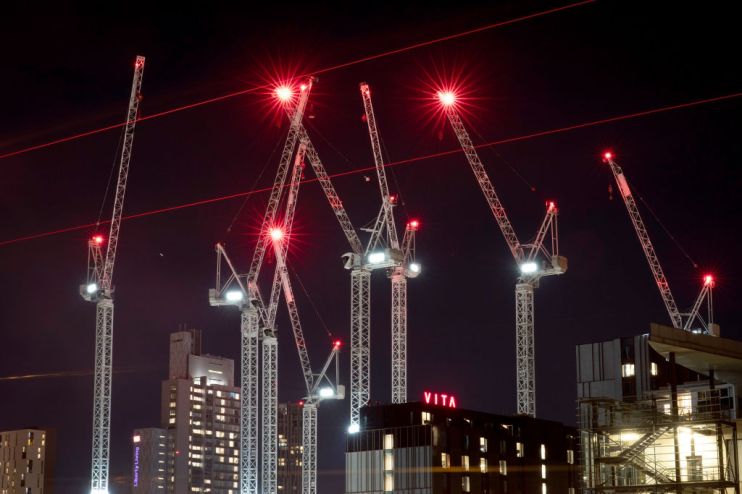The cranes of Manchester tell a tale of a city that said yes to Yimbyism

As the novelist Karl Ove Knausgaard wrote: “There are few things I find more beautiful than cranes”.
Officially, the symbol of Manchester is a bee – but it might as well be a crane. These skeletal structures are symbols of the skybound rise of England’s third largest city which this week smashed Welwyn Gardens out of the park to receive the coveted title Yimby City of the Year by campaign group Priced Out.
Once a dirty word, Yimbyism has experienced a resurgence amongst a swathe of policy wonks and columnists online, where it litters bios on X. Such is the Yimby influence – and, in fairness, the blatant lack of affordable or appropriate housing in Britain – that politicians have started to grab club badges with aplomb. Keir Starmer this year announced his membership; Michael Gove, the housing secretary, this week surprised activists by claiming he was also a Yimby, loud and proud.
Yimbys on Twitter deplore the lack of housing in this country. And rightly so. Britain’s highly restrictive ‘discretionary’ planning system has left us with a shortfall of 4.5m houses in the period since 1945, according to the Centre for Cities. In the 1960s Britain built 3.6m homes but in the 2010s we built 1.5m homes – despite significantly higher population growth. Short supply means homelessness and a house price spiral. In the 1980s renters spent 10 per cent of their income on housing; now that’s 30 per cent (or 40 per cent for Londoners).
Yet in this dark climate Manchester has seen an astonishing transformation this century. Just 30 years ago, only 600 people lived in Manchester city centre. Now that number is 600,000. Deloitte’s Crane Watch Survey, which has been going for 23 years, tracks Manchester’s construction activity and boy has it been a buoyant two decades.
What has driven this spectacular boom? One quirk, noted by commentator Aidan O’Rourke, is Manchester’s ability to build upwards. Whilst London is restricted by crippling height restrictions, Manchester has none of these. As any semi-regular visitor to Manchester over the past few years will concur, the skyline becomes unrecognisable every few months due to the number of skyscrapers cropping up from Stretford to Islington Mill (accompanied, of course, by a sea of tastefully curated cranes).
London does a good job cosplaying as a tall and spiky city. But as the LSE’s Paul Cheshire points out, Paris in 2010 had eight times as many skyscrapers as London – despite ostensibly seeming flatter. London’s height restrictions mean tall buildings are often approved if they are designed by so-called trophy architects: a quarter of the city’s skyscrapers are designed by these maestros. In Chicago, Cheshire says, the home of modern architecture, only three per cent of stratosphere grazers are designed by the architectural elite.
All this dizzying development has got some woozy commentators dubbing the city “Manc-hatten”.
The reinvigoration of Manchester’s Deansgate Square introduced four new skyscrapers. In 2018, South Tower became the city’s highest tower at 65 floors strong. That will change when Trinity Islands is completed. Just an amble along the Irwell river to the south east, a memorable walk truncated by the stunning view of cranes at work in the horizon, there will soon be five towers, the tallest of which will be nearly 700 feet and become the highest building in Britain outside the capital. All this dizzying development has got some woozy commentators dubbing the city “Manc-hatten”.
But – before you cry gentrification – importantly, the spirit of Madchester lives on. The momentous musical and cultural scene of the 1980s may no longer facilitate all-nighters at the now-defunct Hacienda but nightlife in Manchester remains the best the UK has to offer – whether your vibe is student (jaegerbomb-heavy Factory), queer (Canal Street is thriving) or more underground (two words: White Hotel). The arts scene is second best to London’s and still developing; Factory International, a £240m arts centre, opened in June and represented the largest public investment in a UK cultural project since the Tate Modern in 2000.
Culture matters not just to young artsy students. If there’s no vibe, builders won’t bother and Manchester’s ability to attract investment has been admirable.
This matters not just to young artsy students. If there’s no vibe, builders won’t bother and Manchester’s ability to attract investment is admirable. The City Council puts its high levels of investor confidence down to strong ambition, long-term thinking and partnership work. A sweep of tech firms have moved in. Talktalk, Siemens and Amazon all have offices up north while Salford is, famously, home to Media City. Deloitte found leisure and retail space delivered in 2022 increased by 12 per cent compared to the previous year.
In 2018 construction rates in Manchester were 10 times the national average. And though interest rates and inflation levels have done their best to batter the building, our third biggest city has become a bastion of building. Cranes still rule the skyline. As Priced Out put it: “London and the South East would do well to take a page out of Manchester’s book.”